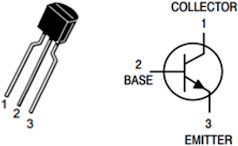Lesson 2 - White noise generator
I decided to try following synthnerd's blog to create a white noise generator. It worked! In the process, I learned several things.
NPN bipolar junction transistors (BJT)
As a brief recap, here's an illustration of an NPN transistor (the position of collector and emitter may be swapped in some models, always check the datasheet *and* with the tester in the multimeter):
At this point, I thought one would put the load at the emitter; however, in all the examples I have seen so far, people ground the emitter and connect the load to the collector. This seems to be called the common emitter configuration, where "common" here means "ground".
Reverse bias leads to electrical breakdown
The trick to generate white noise comes from physically imposing $V_B<V_E$, for example by grounding the base (where $V_B=0$ by definition) and putting the emitter at +9V. This way, we are reverse-biasing the PN junction between base and emitter.
If the applied voltage is large enough (in magnitude), the reverse bias causes an electrical breakdown. For example, diodes have a parameter called breakdown voltage, that is the minimum reverse voltage that makes the diode conduct appreciably in reverse. Breakdown is a generic term that can take different forms (avalanche noise, zener effect, and possibly others). See the graph below for zener diodes, where the breakdown voltages are due to different physical phenomena and correspond to the knees of the two curves:
In transistors, one observes a similar effect due to reverse biasing the base-emitter junction. This results in current behaving like white noise at the emitter. People use this noise for random number generation, for instance; we want to use it for making sounds.
The breakdown phenomenon itself is not destructive, but could lead to excess heating. So it's a good idea to check the ratings, for example forThe amount of noise created will depend on the physical characteristics of the junction, such as used materials and doping levels.
BC182L x rimpiazzato con BC550C
There's usually a high resistance at the node you measure voltage from. The noise itself is best described as a noise current, but that high resistance gets you a voltage.
is white noise always in the audible spectrum? maybe should check the bandwidth?


Comments
Post a Comment